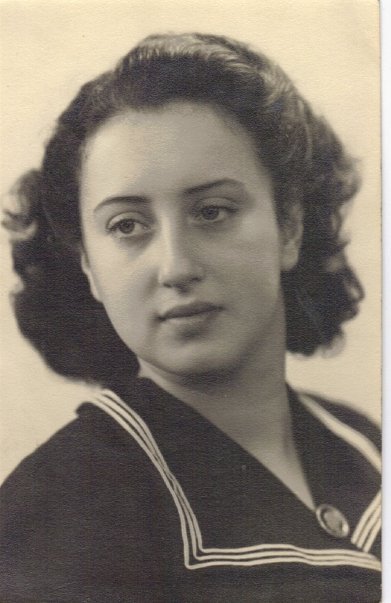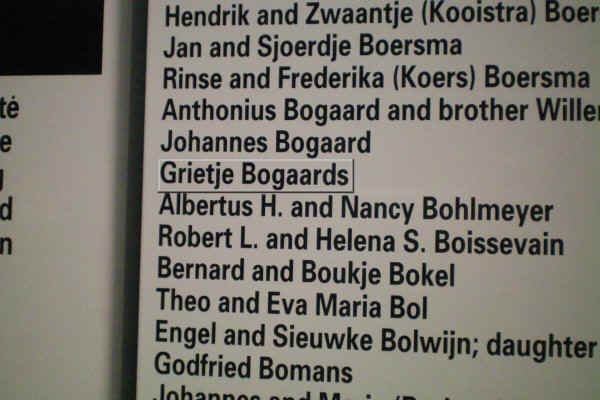

 Elisabeth,
called Elly by family and friends, was eleven years old in 1942 when she
went into hiding with her parents and her older brother Henry. Elly had
been attending the Jewish Secondary School in Amsterdam, a development
which was the result of full-scale segregation of Dutch Jews in all public
accommodations since the start of the Nazi occupation of Holland in 1940.
There was another Jewish girl who was attending the same school as Elly.
Her name was Anne Frank.
The world would come to know her story of courage and kindness through
her diary, which was found and published after she died of typhus in Bergen-Belsen
in March of 1945. Elly's story is very similar except for the ending. Elisabeth,
called Elly by family and friends, was eleven years old in 1942 when she
went into hiding with her parents and her older brother Henry. Elly had
been attending the Jewish Secondary School in Amsterdam, a development
which was the result of full-scale segregation of Dutch Jews in all public
accommodations since the start of the Nazi occupation of Holland in 1940.
There was another Jewish girl who was attending the same school as Elly.
Her name was Anne Frank.
The world would come to know her story of courage and kindness through
her diary, which was found and published after she died of typhus in Bergen-Belsen
in March of 1945. Elly's story is very similar except for the ending. |
|

Elisabeth Rodrigues, shortly after the liberation of Holland, ca. 1947.
Elly's Hebrew school report card for the year she went into hiding
shows a girl with great potential. The language is Dutch.
|
Report Card Front Cover: Portuguese-Jewish Religious School 1941-1942 |
Report Card Back Cover: Portuguese-Jewish Religious School |
|
Inside of Report Card of Elisabeth Rodrigues 1941-42 |
|
|
|
| Elly's father had received word that their hiding place was
about to be discovered. The family made a daring midnight transfer to the
new hiding place, which would turn out to be the first of many in the coming
months. They traveled by hearse, which was one of the vehicle types the
Nazis did not interfere with. The other was the ambulance. By the winter 1943, Abraham Rodrigues made the decision to stop running. With the help of business contacts and the Dutch underground, Abraham left his daughter with a school teacher who lived in a rural village in the south of Holland. Henry was placed in a nearby village as well. Once safe, Elly's mother and father hoped to find a safe place in one of Holland's urban centers. Elly's foster mother would later be called Aunt Grace (Tante Grie, in Dutch) by Elly's children. |
|
|
Lea and Abraham Rodrigues, Elly and Henri's parents, before the war. |
|
|
Click to enlarge |
 |
Elly and her foster mother, Grietje "Grace" Bogaarts, ca. 1958. |
Abraham made numerous trips to the village to supply Grace with falsified documents to support Elly. In the early months of 1944, Elly's parents had been betrayed and arrested. With Elly vulnerable and no source of support, Grace decided to take Elly into hiding in the Northern coast of Holland. they spent the next six weeks in another attic together, sharing their food, space, and their faith. Months later, Grace was given the word that returning to her own village would calm suspicions and constitute the safest move. So they returned in the fall of 1944. The villagers later revealed that they suspected Elly of being Jewish, but they refused to betray their fellow Dutch citizens and human beings.
 Elly
and her brother were able to come out of hiding, but she would never see
her parents again. In 1960, the International Red Cross notified Elly that her parents had
been gassed in Auschwitz. Grace became Elly's legal guardian at the end
of the war in 1945, and they continued a relationship that lasted until
her death in 1964. In 1983, when the names for the Wall of the Rescuers
were being collected, Elly submitted the name of her foster mother, Grace
"Grietje" Bogaarts, to the United States Holocaust Memorial Museum committee
as one of the righteous gentiles who protected Europe's Jews during World
War II. In 1986, Henry Rodrigues, Elly's brother, sent a letter to Yad Vashem,
the Holocaust memorial Museum of the state of Israel, requesting that Grietje
Bogaarts, and her sister Aartje Ketel, be included in the list of the
"Righteous Gentiles" who had risked their lives to hide and harbor
Jews from the Nazis during the occupation of Europe. (Henry
Rodrigues' letter to Yad Vashem can be viewed here in part in PDF format).
Elly
and her brother were able to come out of hiding, but she would never see
her parents again. In 1960, the International Red Cross notified Elly that her parents had
been gassed in Auschwitz. Grace became Elly's legal guardian at the end
of the war in 1945, and they continued a relationship that lasted until
her death in 1964. In 1983, when the names for the Wall of the Rescuers
were being collected, Elly submitted the name of her foster mother, Grace
"Grietje" Bogaarts, to the United States Holocaust Memorial Museum committee
as one of the righteous gentiles who protected Europe's Jews during World
War II. In 1986, Henry Rodrigues, Elly's brother, sent a letter to Yad Vashem,
the Holocaust memorial Museum of the state of Israel, requesting that Grietje
Bogaarts, and her sister Aartje Ketel, be included in the list of the
"Righteous Gentiles" who had risked their lives to hide and harbor
Jews from the Nazis during the occupation of Europe. (Henry
Rodrigues' letter to Yad Vashem can be viewed here in part in PDF format).

Another view of the Wall of the Rescuers, USHMM
Click to enlarge.
My first daughter was named after "Grace" Bogaards, demonstrated
the best God-given traits of human nature. When I see Grace, I see the
miracle of life that was given to my mother through her namesake, Grace
"Grietje" Bogaarts.)
The story, of course, does not end here. To find out how Elisabeth met Ernest, read the epilogue. But first, learn about the experiences of Elly's husband, Ernest H. Cassutto.
To The Cassutto Memorial Page |
To The Ernest Cassutto Story |
To The Elisabeth Rodrigues Cassutto Story |
To Mr Cassutto's Personal Page |
To
Cyberlearning-
|
Pages and images by George Cassutto © 1994-2008
Reproduction prohibited without permission.
To The Interdisciplinary Units Page |
To The Beast Within Page |